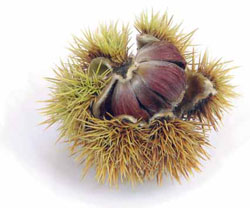Sweet chestnut tannins for pigs

Tannins are widely found in plant material and can have diverse effects on animals consuming them. It is generally accepted that there are two structural types of tannins in nature: ‘condense’ tannins and ‘hydrolysable’ tannins. Despite being known for some of their anti-nutritional properties, the hydrolysable forms can support health and nutrient digestion in pigs.
Tannins are water-soluble polyphenolic compounds and are common in fruits, tea, legume forages and trees and grasses. The word “tannin” is very old and reflects a traditional technology. “Tanning” (waterproofing and preserving) was the word used to describe the process of transforming animal hides into leather by using plant extracts from different plant parts of different plant species. But tannins have also found their way into human food and animal nutrition. Most nutritionists are familiar with the “unwanted tannins”, the condense form of tannins that are found in sorghum for example. These tannins reduce palatability and subsequently feed intake and growth when fed to pigs and are therefore an unwanted substance in animal diets. The condense tannins can also reduce amino acid digestibility. Hydrolysable tannins on the other hand can have many benefits for the pigs, both in the feed and in the animal. This article discusses a few studies that looked at the beneficial properties of hydrolysable tannins (“the good ones”) derived from selected chestnut wood (Castanea Sativa Mill), a tree which is found abundantly and mainly in southern Europe.
| Tanin Sevnica: Experts from Slovenia Tanin Sevnica has been cooperating with nature since 1923. The company – based in Slovenia – produces extracts from chestnut and oak wood. With a staff of 130 people, the company produces extracts as tanning agents for vegetable leather tanning. From the extracted wood also other products are produced such as Furfural and Sodium Acetate. Since the beginning of the 90s, the company started with the production of natural extracts from sweet chestnut and oak woods for human and animal nutrition. Around 5% of tannins for animal nutrition that Tanin Sevnica produces are sold in Slovenia, the rest goes to other EU members, Asia, Africa and the Middle East. |
Hydrolysable tannins
Researchers at the Faculty of Veterinary Medicine of the University of Ghent in Belgium studied the use of tannins to control Salmonella Typhimurium infections in pigs. The aim of this study was to determine whether a hydrolysable tannin extract* of sweet chestnut wood has an inhibitory effect on Salmonella Typhimurium survival both in vitro and in vivo in pigs. In a first experiment, the minimal inhibitory concentration (MIC) of the tannin extract on 57 Salmonella Typhimurium isolates was determined. For all isolates, a MIC of 160-320 mug/ml was found. The second in vitro study revealed that Salmonella growth was strongly reduced using tannin extract concentrations of 25-50 mug/ml and nearly completely inhibited at a concentration of 100 mug/ml tannin extract. In an in vivo trial with two groups of six piglets, each group receiving feed with or without the addition of tannin extract (3 g/kg). Then they were orally inoculated with 107 colony forming units of a Salmonella Typhimurium strain. The tannin extract had no effect on faecal excretion of Salmonella, and no differences in colonisation of the intestines and internal organs were demonstrated in pigs euthanised at 4 days post-inoculation. The researchers concluded that the hydrolysable tannin extract used in this study showed strong action against Salmonella Typhimurium in vitro but not in vivo.
Feed efficiency
Researchers at the University of Bologna in Spain and the University of Munich in Germany looked at the in vitro and in vivo effect of different levels of tannins (using a chestnut wood extract containing 75% tannins**) on growth performance, intestinal microbiota and gutwall morphology in piglets. The study consisted of an in vitro trial and a feeding trial. In the animal trial, the utilisation of tannins did not significantly influence animal weight gain but improved feed efficiency when tannins were fed at 4.5 g/kg of diet.
Viable counts of Lactobacilli tended to be increased by tannins in the jejunum, while bacterial caecal counts were not affected. Depth of ileal crypts tended to decrease in piglets fed tannins at 2.25 and 4.5 g/kg. In the present in vitro study, tannins had a strong influence on the metabolism of swine caecal microbiota. In fact, increasing concentrations of tannins linearly reduced total gas production and concentrations of acetic, propionic, and n-butyric acid, showing an inhibitory effect on the activity of caecal bacteria. The present study showed that feeding weaned piglets with a tannin-rich wood extract can result in improved feed efficiency and reduction of intestinal bacterial proteolytic reactions. The growth-enhancing effect that tannins had on Enterococci and Coliforms under in vitro conditions deserves further investigation according to the researchers.
Antioxidant activity
Another study with hydrolysed tannins** looked at their effect they have on oxidative stress in weaned pigs. The study – performed at the University of Ljubljana in Slovenia – had six treatment groups of eight pigs each (one positive control with linseed oil, one negative control without linseed oil, three groups received a different dosage of tannin: 0.75kg/t, 1.50kg/t or 3.00kg/t and one group received only vitamin E). The lipid peroxidation (in blood plasma and urine), antioxidant status (in plasma), oxidative DNA damage (lymphocytes, urine) and hepatotoxicity (plasma liver enzymes) were measured for all animals. It was concluded that the tannin product showed evident in vivo antioxidant activity. It reduced the degree of lipid peroxidation, diminished lymphocyte DNA damage and had a beneficial effect on the liver of pigs that were under oxidative stress induced with high PUFA intake. The highest antioxidant activity was observed in the group of pigs that received 3.0 kg of tannins per tonne of feed, which was also higher than the group that received the vitamin E supplement at 100mg/kg feed). The researchers address that dosages and efficacy of the tannin depend on breeding goals and purposes, breeding system and rearing practices, feed composition, animal effect and climate conditions.
| How do tannins work? Hydrolysed tannins work both in the feed and in the animal gut. In the feed they act as natural preservatives and prolong the feed stability. It also binds protein in the feed. In the pig’s digestive system, the tannins have an astringent effect. This means that they create a slower passage of the feed in the gastrointestinal tract, reduce diarrhoea and increase growth rates. These results are due to several effects that tannins have on both the immune system (antioxidant and antiradical effects) and the microbiological flora (inhibition of E coli, Salmonella among others and positive effect on the growth of Lactobacillus). Adding these tannins to the diet also shows an environmental effect as less methane and ammonium is excreted (ruminants) and less and better manure quality of the animals. |
Conclusion
Tannins can have beneficial effects on the digestion and hence animal performance when they are incorporated in animal diets. However, the great diversity of the results presented in different papers, related to the chemical composition and source of tannins, specific reaction of different animal species to tannins in feeds or supplements and to the dose-response of animals indicate the necessity of further investigations to have more data on the mode of action and potency of these compounds applied in animal diets.
* Globatan®
* Farmatan®











